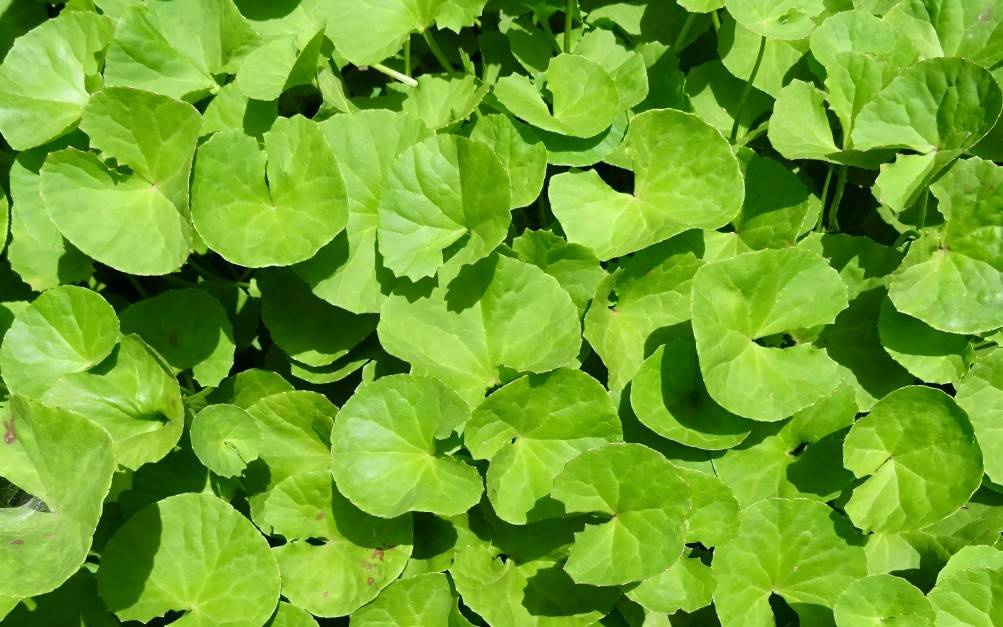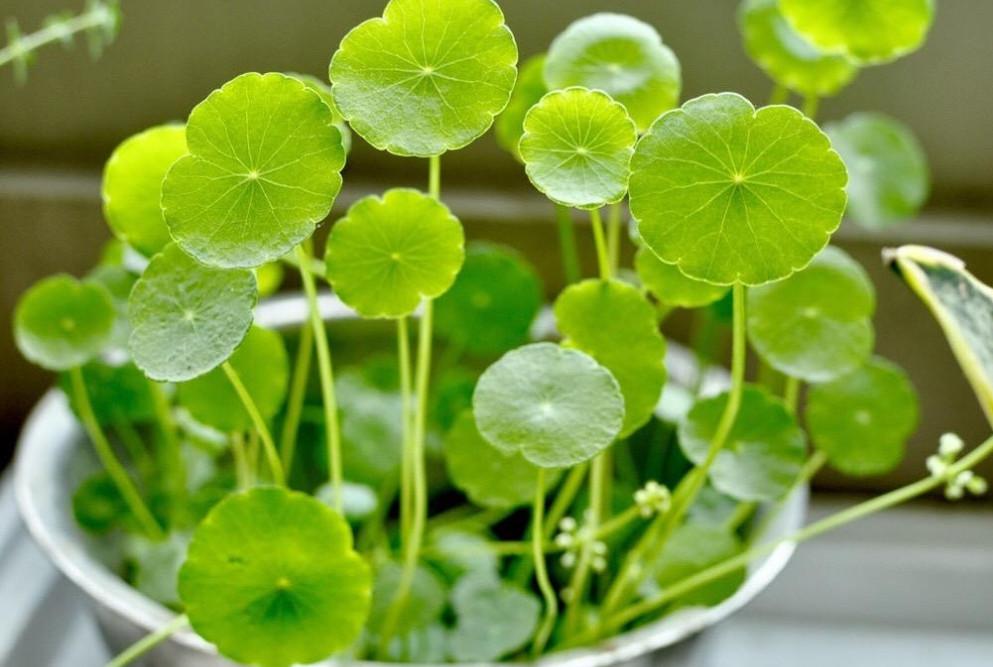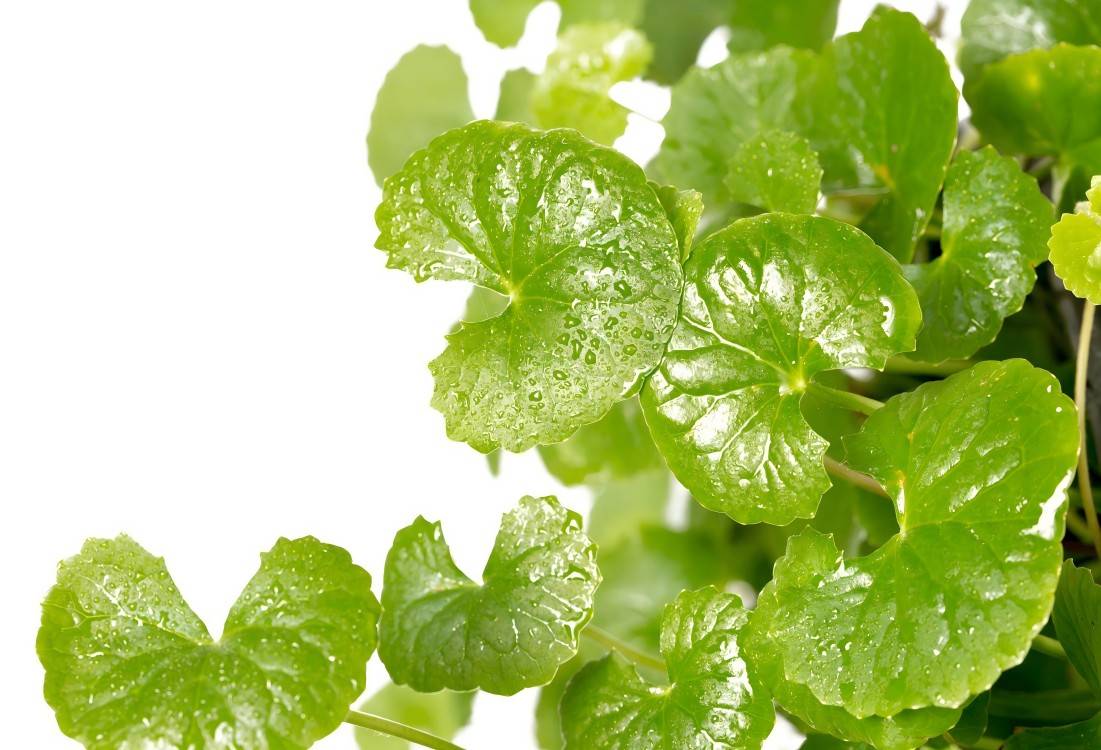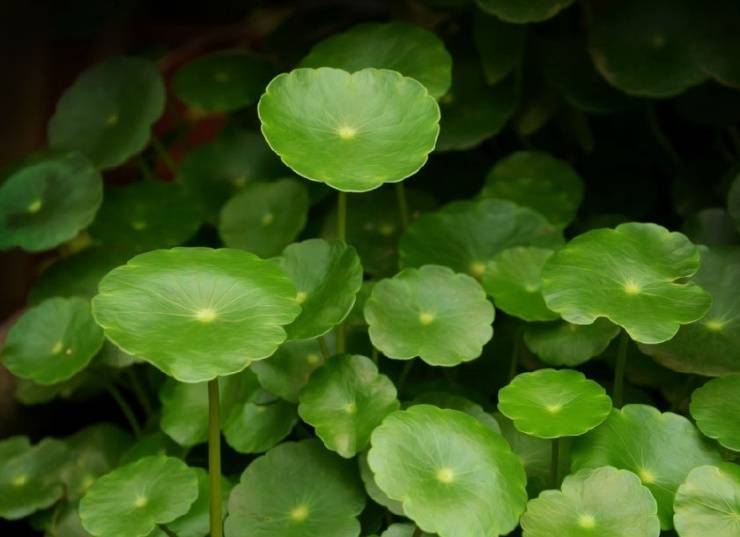What Is the Benefit of Gotu Kola in Telugu?
Centella asiatica (Centella asiatica), also known as Lei Gong Root, Avalanche Bowl, Horseshoe Grass, Copper Coin Grass, and Lok Tak Ta, etc., is widely distributed in the southern region, and grows in slightly moist and fertile roadsides, ditches, and fields. It has the efficacy of clearing away heat and dampness, detoxifying and eliminating swelling, and is mainly used for the treatment of damp-heat jaundice, heatstroke and diarrhea, lithiasis, hemorrhagic lymph, carbuncle sores, bruises, etc. [1].
There are many records of Gotu Kola in ancient books in Telugu. Centella asiatica has been used in the treatment of various clinical diseases since ancient times in Telugu. In recent years, with the improvement of science and technology, scientists have successfully extracted various useful components from Gotu Kola, such as centella asiatica acid, centella asiatica glucoside, pomelanone, methyl linoleate, etc., which are widely used in medicine and cosmetology [2,3], and the mechanism of its therapeutic effect has been widely studied and explored, and the mechanism of its therapeutic effect and its clinical application have also become a hot spot of the research in recent years. Therefore, this paper summarizes the mechanism of action and clinical application of Centella asiatica in recent years, in order to provide some references for exploring the mechanism of action of Centella asiatica, the rational use of clinical medication and the development of new drugs.
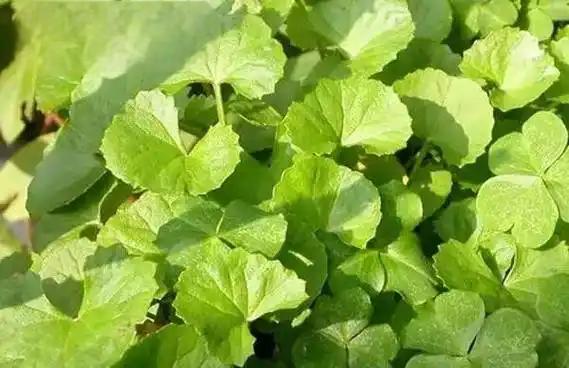
1 Mechanism of action
1.1 Anti-inflammation
Inflammation induces inflammatory reaction through interleukin (IL), tumor necrosis factor-α (TNF-α) and nuclear factor-κB (NF-κB), causing redness, swelling, heat, pain and other symptoms, which is a kind of self-defense and repairing process of human body. Ferah et al[4] demonstrated that Centella asiatica could effectively alleviate cisplatin-induced liver injury in rats by reducing the release of AST, ALT and ALP enzymes and oxidative stress, and concluded that Centella asiatica could reduce cisplatin-induced liver injury by inhibiting the signaling pathways of TNF-α, IL-1β and NF-κB, thus achieving a reduction in liver injury. It was also concluded that Centella asiatica could reduce inflammation by inhibiting TNF-α, IL-1β and NF-κB signaling pathways. Through animal experiments, Xu Chen et al.[5] found that the anti-inflammatory mechanism of Gotu Kola may be related to the inhibition of TLR4/NF-κB signaling pathway, and Huang Yalan[6] demonstrated that Centella asiatica glucoside, an effective constituent of Centella asiatica, was able to increase the up-regulation of PPARy protein expression, and inhibit the expression of the inflammatory factors IL-6, TNF-α, and IL-1, thus exerting an anti-inflammatory effect.
Another study[7] showed that the effective extract component of Centella asiatica could reduce the inflammation of cerebral arterial vascular tissues in rats with cerebral aneurysm and decrease the size of the tumor, and its mechanism of action was to down-regulate the expression of TLR9/MyD88 protein in the model rats to achieve anti-inflammatory effect, and ultimately to achieve the effect of reducing the size of the tumor. Another study[8] showed that Centella asiatica could reduce the activities of interleukin-1β (IL-1β), interleukin-6 (IL-6), tumor necrosis factor α (TNFα), prostaglandin E2 (PGE2), cyclo-oxygenase-2 (COX-2), and lipoxygenase (LOX), and thus achieve anti-inflammatory effects through synergistic effects of multimolecular pathways.
1.2 Anti-fibrosis
Fibrosis can occur in multiple organs, and its main pathological changes are the increase of connective tissue and the decrease of parenchymal cells in organ tissues, and its continuous progression can lead to serious damage to organ structure and function, and even cause death due to organ failure. Research[9] found that Centella asiatica glucoside can significantly improve the renal function of rats with unilateral ureteral obstruction, and it is also hypothesized that Centella asiatica can inhibit the protein expression of connective tissue growth factor (CTGF) and collagen III (ColIII) in the renal interstitium, which is useful to prevent and control renal interstitial fibrosis. Feng Rui[10] examined the effect of Centella asiatica granules on the protein expression of smad3 and smad7 in rats with unilateral ureteral obstruction model, and proved that Centella asiatica could inhibit the protein expression of smad3 and promote the protein expression of smad7, which indicated that it could play a role in delaying renal tubulointerstitial fibrosis by regulating the expression of smad3 and smad7.
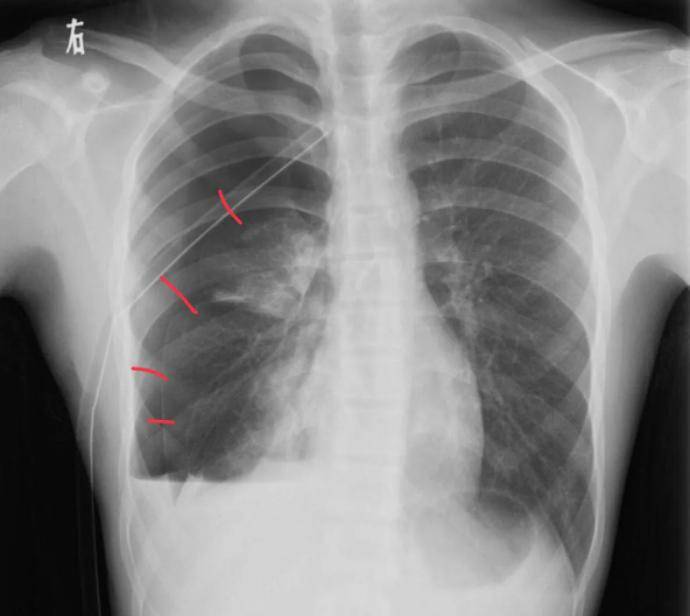
Li Jing [11] established a cellular immunity and fibrosis model of systemic sclerosis by subcutaneous injection of bleomycin, and detected the mRNA of JAK2 and STAT3 and the expression of STAT3 protein by fluorescence measurement technology, confirming that cumquat glucoside was able to alleviate inflammatory response and fibrosis in the model rats. Some studies[12] showed that angiotensin II was infused through subcutaneous micro-osmotic pumps to construct a model of myocardial fibrosis in mice, and it was found that cumquat glucoside could inhibit AKT/mTOR/p70S6K signaling, enhance AMPK expression, reduce α-SMA expression, enhance autophagy activity of cardiac myocytes and reduce extracellular glial secretion, and finally inhibit cardiac myocyte fibrosis. The final result is the inhibition of cardiomyocyte fibrosis.
1.3 Anti-oxidation and apoptosis
Antioxidant and apoptosis are important mechanisms of Centella asiatica, and its pathways of action are also complicated. Pan Xiaocui et al.[13] extracted the total glycosides of Centella asiatica and verified their antioxidant properties, and confirmed that the total glycosides of Gotu Kola have good antioxidant properties. Visarut et al [14] demonstrated that Centella asiatica up-regulated cellular antioxidant enzymes and believed that it played a major role in the protection against oxidative stress, while another study [15] demonstrated that Centella asiatica activated the antioxidant-regulated transcription factor NRF2, which plays an antioxidant role. Another study[15] demonstrated that Gotu Kola could activate NRF2, an antioxidant-regulated transcription factor, and play an antioxidant role. Feng Shanshan et al.
Other studies [17,18] showed that Gotu Kola could inhibit the NLRP3 inflammatory vesicle signaling pathway, up-regulate the HO-1 protein and down-regulate the expression of NOX4 protein to achieve antioxidant effects. Wang Yao et al.[19] found that centella asiatica glucoside could promote apoptosis by inhibiting the expression of micromolecule RNA-564 (miR-564) in human proliferative scar fibroblasts (HSFB), which in turn inhibited the activation of the TGF-β_ 1/Smad signaling pathway. Jiang Bin et al.[20] intervened human cervical cancer cell line C-33A/CaSki by using different concentrations of hydroxycitrin, and detected the proliferation inhibition effect of the drug by MTT method, and found that it promoted apoptosis by up-regulating the expression of apoptosis-promoting factors, such as Bcl-2 and Bcl-xl, and by down-regulating the expression of apoptosis-promoting factor, Bax.
1.4 Anti-tumor and damage repair
Anti-tumor and damage repair are also important mechanisms of Gotu Kola. In a study[21] , through cell survival and colony formation assays, it was found that the constituent of Centella asiatica, Asiatic acid (AA), could evoke mitochondria-induced apoptosis in osteosarcoma (OS) cells by inhibiting the JAK2/STAT3 pathway and the expression of MCL-1, and thus achieve the antitumor effect.Naidoo et al.[22] investigated the effects of Centella asiatica extract (C-LE) on leukemia THP-1 cells and normal peripheral blood mononuclear cells. Naidoo et al. [22] investigated the effects of Centella asiatica extract (C-LE) in leukemic THP-1 cells and normal peripheral blood mononuclear cells (PBMC) on the modulation of antioxidants, cytokines, and cell death. It was demonstrated that C-LE could effectively regulate antioxidant activity, inflammatory cytokines, and cell death in both PBMC and THP-1 cells, and that it decreased the levels of pro-inflammatory cytokines and increased the levels of anti-inflammatory cytokines in THP-1 cells, which led them to hypothesize that its antitumor mechanism might be related to this effect. In THP-1 cells, C-LE decreased the level of pro-inflammatory cytokines and increased the level of anti-inflammatory cytokines, and it was hypothesized that its anti-tumor mechanism might be related to this.
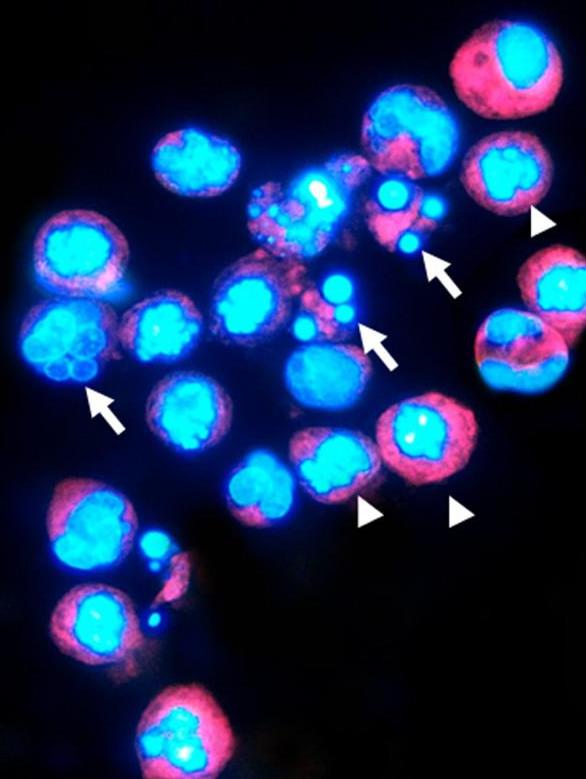
In terms of injury repair, Wu Yanwen [23] established an animal model to experimentally study the mechanism of action of cumquat glycoside in the treatment of burn wounds, and concluded that cumquat glycoside can inhibit the overexpression of inflammatory response by increasing the expression of cell cycle protein B1 (CyclinB1), proliferating cell nuclear antigen (PCNA), and inhibiting the nuclear transport of p65 protein, the main subunit of NF-κB, to achieve the effect of repairing wounds. Inhibition of nuclear translocation of p65 protein, the main subunit of NF-κB, inhibits the overexpression of inflammatory response and achieves wound repair. Ying Liu et al. [24] demonstrated that water-soluble Asiatic acid glucosamine salt (AAGS, in gel form) can promote the inflammatory process in the early stage of trauma to enhance neoplastic tissue formation, and induce macrophage M2 polarization in the late stage of trauma to remodel and regenerate skin structure, which is a good effect of injury repair. Another study [25] hypothesized that centella asiatica glucoside may promote collagen maturation and wound healing by affecting the expression of heat shock protein 47 (HSP47), thus reducing scar formation and promoting wound repair.
1.5 Other mechanisms and effects
There are many mechanisms of action of Centella asiatica, and more and more of them have been discovered with the progress of science and technology. For example, Tian Xulu et al.[26] observed the effects of centella asiatica total glycosides on gastrointestinal motility and enteric nervous system (ENS) by establishing a rat model of senile dyspepsia (FD) and suggested that centella asiatica total glycosides may promote the release of endogenous gastrin (MTL) and inhibit the secretion of vasoactive intestinal peptide (VIP), inhibit glomus cell-derived neurotrophic factor (GDNF), and the downstream activation of signaling pathways, and promote the activation of ENS and enteric nervous system. It also inhibits the activation of GDNF and downstream signaling pathways, and promotes the repair of ENS and enteric neurons. Fu Lianqiao et al. [27] demonstrated that cumquat chloride could inhibit interleukin 1β (IL-1β)-induced chondrocyte injury, and hypothesized that the mechanism might be related to the modulation of miR-342-5p/AQP3 protein pathway by cumquat chloride. In another study[28] , it was shown that cumquat glucoside could reduce the inflammatory injury caused by hyperoxia in neonatal rat lungs by down-regulating the expression of miR-155 and up-regulating the expression of SOCS1 to improve the symptoms of bronchopulmonary dysplasia. Another study demonstrated the protective effect of centella asiatica glucoside on myocardial ischemia/reperfusion injury and inhibition of the MAPK signaling pathway in rats [29].
2 Clinical applications
2.1 Chronic kidney disease
Gotu Kola is effective in the treatment of chronic kidney disease and has unique advantages. Zhang Min et al [30] collected clinical data of 80 cases of chronic kidney disease patients from nephrology clinics and divided them into a control group and an observation group according to the different treatment plans. The control group was given conventional Western medical treatment, and the observation group was treated with Gotu Kola granules, comparing the efficacy of the two groups, improvement of Chinese medicine symptom points, and quantification of urinary proteins before and after treatment, and the results showed that the effective rate of the observation group's treatment was significantly higher than the control group's, and the Chinese medicine symptom points were significantly lower than the control group. The results showed that the treatment efficiency of the observation group was significantly higher than that of the control group, and the TCM symptoms points were significantly lower than that of the control group. The quantitative values of urinary protein, urea nitrogen (BUN) and creatinine (Scr) of the observation group were significantly lower than that of the control group, and the e GFR was significantly higher than that of the control group.
Li Xiaoyan et al. [31] randomly divided 45 patients with chronic glomerulonephritis and chronic kidney disease stage 4-5 into treatment group and control group. The treatment group was treated with Compound Centella asiatica formula on top of basic western medicines, the treatment group was treated with Compound Centella asiatica formula on top of basic western medicines, and the control group was treated with basic western medicines for a total period of 12 weeks, and the quantitative 24-hour urine protein, blood creatinine, blood urea nitrogen of the patients were observed, Blood uric acid, blood urea nitrogen, serum albumin, blood hemoglobin, glomerular filtration rate, subjective overall nutritional score and other indicators of the changes of the patients, the results showed that the total effective rate of the treatment group was 40%, the total effective rate of the control group was 20%, the difference between the two groups was statistically significant, the difference of the treatment group before and after the comparison of the values of the 24-hour urine protein quantitative, blood creatinine, etc. was not statistically significant, confirming that the compound Centella Asiatica formula can reduce proteinuria and improve the nutritional status of the patients. This confirms that the compound formula of Centella asiatica can reduce proteinuria, improve the nutritional status of patients, and stabilize the renal function of patients with chronic kidney disease stages 4-5.
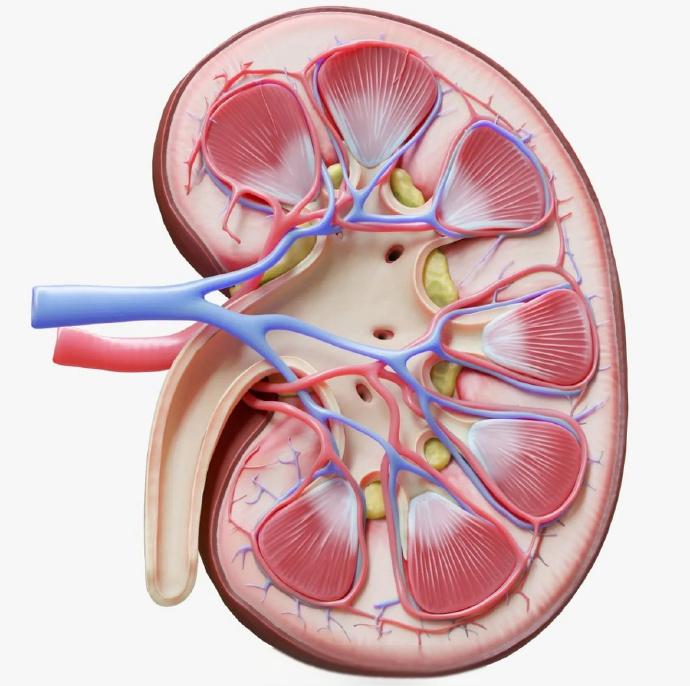
Liu Xiaoju [32] believes that dampness, turbidity and drowning toxicity is an important link in the development of chronic renal failure, and various reasons lead to damage to the lungs, spleen and kidneys, fluid metabolism disorders, resulting in dampness, turbidity and internal stagnation, and the accumulation of long-lasting heat and toxin, ultimately becoming heat toxicity, dampness toxicity, through the selection of Gotu Kola, Cynomolgus, zeidian, patchouli and rhubarb wine, the use of the combination of the combination, from the turbidity, turbidity, turbidity drainage three perspectives so that to get rid of the turbid toxicity of chronic kidney disease, clinical application of good results in the treatment. The clinical application of the combination of rhubarb and wine was found to have good efficacy. Another clinical study [33] confirmed that Centella asiatica compound formula can reduce the amount of 24-h urine protein in patients with chronic glomerulonephritis-induced chronic kidney disease stage 3, slow down the progression of nephropathy, and improve renal function, which has a definite efficacy in chronic glomerulonephritis CKD stage 3, and the safety is good.
2.2 Diabetic nephropathy
Gotu Kola has the efficacy of clearing heat and inducing dampness, detoxifying and eliminating swelling, and it is often used in the clinic with dampness-inducing and blood-activating medicines to eliminate dampness, silt, turbidity and toxins in the treatment of diabetic nephropathy (DN). Professor Sun Wei [34], according to the fact that stasis is inevitable when the disease is prolonged, and that the disease enters the collaterals after prolonged illness, used Angelica sinensis with Centella asiatica and Ghost's Arrow Feather to invigorate blood and collaterals, to treat renal failure caused by diabetic nephropathy (deficiency of the spleen and kidney, and the evidence of dampness, stasis, turbidity, and toxin), and formulated a formula for diabetic renal failure. The formula was found to be effective in delaying the symptoms of renal failure caused by diabetic nephropathy and improving the index effect.
Eddie Sun[35] concluded that compound cumulus herb combination has the effect of breaking up accumulation and eliminating stasis, clearing heat and inducing dampness, and can significantly reduce urinary protein. 60 cases of patients diagnosed with early-stage DN were divided into 30 cases each in the observation and control groups according to the order of diagnosis, and the control group and the observation group were given the same basic treatment, while the observation group added compound cumulus herb combination for internal use on the basis of the basic treatment, and the symptoms and signs and changes in laboratory tests of the patients were recorded after three months, and the results were analyzed. After 3 months, patients' symptoms, signs and laboratory tests were recorded before and after, and the symptoms were scored and evaluated. Laboratory indexes such as UAER, Scr and BUN decreased compared with the pre-treatment period, and the level of laboratory indexes in the observation group was significantly lower than that of the control group, and the decrease was even more obvious, with statistically significant differences between the groups, and the total effective rate of the observation group was significantly higher than that of the control group (90% vs. 30%), with statistically significant differences. It is clinically proven that on the basis of western medical treatment, the addition of Compound Centella Asiatica Compound can significantly reduce the urinary albumin excretion rate (UAER) of patients with early-stage DN, reduce the excretion of urinary proteins, and alleviate the symptoms of patients.
Chai Ke et al[36] showed that the compound formula of Centella asiatica No.2 could effectively improve the level of urinary protein and renal function indexes in patients with diabetic nephropathy, and pointed out that the compound formula of Centella asiatica might have a positive effect on the control of lipids in patients, and also improve the quality of life of patients with a high degree of safety. Other studies[37,38] have also confirmed that the addition of Centella asiatica compound formula to western medical treatment can improve the treatment effect of diabetic nephropathy.
2.3 Chinese herbal enema and wound healing
Chinese herbal enemas containing Centella asiatica and the promotion of wound healing are also common clinical applications of Centella asiatica. Prof. Fang Cantu[39] created the “Compound Gotu Kola Enema” with the following basic formula: 60 g of Centella asiatica, 50 g of Fructus Schisandrae, 30 g of Radix Angelicae Sinensis, 30 g of Radix et Rhizoma Asiatica, 20 g of Rhizoma Dahuang, 20 g of Calcined Oyster (decocted first), 20 g of Sophora florida, 20 g of Fructus Psoralea, 15 g of Radix Bitter Ginseng, to support the positive and dispel the evil, to attack and break, to tonify and nourish, and to promote the healing of wounds. It was used to treat malignant intestinal obstruction with good results.
Wu Jiaming et al[40] divided 80 cases of colorectal cancer complicated with malignant intestinal obstruction that met the inclusion criteria into 40 cases each in control group and treatment group randomly, and the control group was given gastrointestinal decompression, fasting and other conventional internal medicine conservative treatments, and the treatment group was given the retention of compound Centella asiatica enemas on the basis of the treatment of the control group, and the efficacy of the two groups was observed and the time of symptomatic relief was observed, and it was proved that the efficacy of compound Centella asiatica enemas was better in the treatment of acute intestinal obstruction, and the results proved that it had good efficacy. The results proved that the efficacy of compound Centella asiatica enema in the treatment of acute intestinal obstruction was better, and the adverse reactions could be controlled.
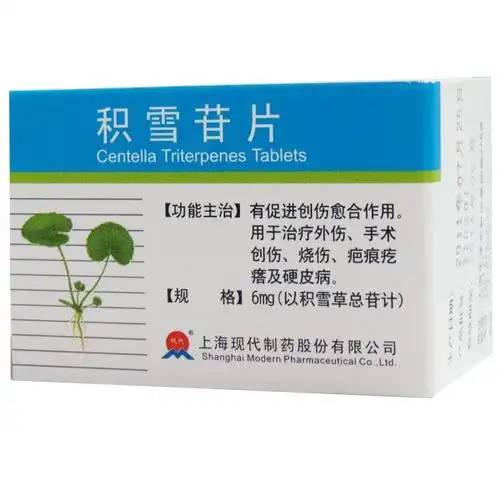
Zhong Hairong et al[41] collected 78 patients with skin injury after keloid in outpatient clinic as the research object, and randomized grouping, the observation group was treated with Centella asiatica glycosides on the basis of the control group, and observed the changes of the indicators of the disappearance time of the pain symptom, the hospitalization time, the time of medication, and the time of skin healing in the two groups, and the results showed that the effective rate of 79.49% in the control group, and the effective rate of 89.74% in the observation group, and the clinical efficacy of the two groups was comparable. Comparison of the clinical efficacy of the two groups of patients, the difference is statistically significant, the disappearance of pain symptoms, hospitalization time, medication time, skin healing time, total dose of irradiation of the two groups, the difference is statistically significant, which concludes that the treatment of keloid skin injury with centella asiatica glycosides has significant clinical efficacy, can effectively alleviate the clinical symptoms of the patients and shorten the length of hospitalization.
Zhou Ling et al. [42] selected 60 cases of hospitalized keloid patients and grouped them by randomized numerical table method. The control group was treated with fractional CO2 laser, and the experimental group was treated with asiaticoside cream ointment on top of it, comparing the degree of improvement of keloid scars, collagen fibers, and the level of heat-shock proteins in the patients in the two groups, and the results demonstrated that the fractional CO2 laser combined with the asiaticoside cream ointment could improve the scar, collagen fibers, and heat-shock proteins of the patients effectively. The results demonstrated that the combination of fractional CO2 laser and cumenexin cream ointment was effective in improving scarring, collagen fibers, and heat shock protein 47 in patients, with better efficacy and lower incidence of adverse effects. Another study [43] showed that the introduction of cumenexin cream into the skin roller needle for the treatment of early hyperplastic scarring, using the roller needle to make the drug better penetrate into the scar tissue, so that the drug can better act on the scar tissue, which can better improve the scar symptoms of the patients, and achieve the purpose of preventing and controlling the proliferation of keloid scars.
2.4 Other clinical applications
In addition to the above clinical applications, there are many successful cases of clinical application of Gotu Kola. Hu Nan et al. [44] collected 92 cases of limited scleroderma through outpatient clinics and randomly grouped them into 46 cases in each group, the control group was given trinitrotoluene treatment, and the experimental group was given Centella asiatica glycoside adjuvant treatment on the basis of the control group treatment, and the two groups were compared in terms of the total effective rate of the treatment, calreticulin A (S100A8), calreticulin B (S100A9), and the points of the clinical symptoms in the first 6 months of treatment, etc. The results showed that the total effective rate of the treatment in the experimental group was 0.5%. The results showed that the total effective rate of the experimental group was significantly higher than that of the control group, and the clinical symptom scores of S100A8, S100A9 and 6 months after treatment were lower than those before treatment, and the experimental group was significantly lower than that of the control group, and there was no obvious adverse reaction during the experiment, which confirms that the adjuvant therapy of cumulus humilis glycosides for the treatment of restrictive scleroderma can significantly improve the body's immune function, and improve the relevant symptoms, and has the characteristics of safety and reliability. safety and reliability.
A study[45] demonstrated that the combination of oral administration of Centella asiatica glucoside tablets and external cleansing with dillon extract was effective in the treatment of limited scleroderma, and at the same time, it could reduce the levels of calreticulin A (S100A8) and calreticulin B (S100A9) in the treatment of limited scleroderma. In addition, He Bangyou[46] summarized that clinical idiopathic membranous nephropathy is prone to the characteristic of long-term stagnation of damp-heat and toxicity in the body, and the damp-heat and toxicity are aggravated by the use of hormones, so Centella asiatica is paired with water-permeating and dampness-expelling medicines and blood-activating medicines, so as to effectively get rid of the damp-heat and toxicity without harming the vital energy. Another study [47] investigated the clinical efficacy of total glycosides of Centella asiatica in the treatment of pericardial contracture (CC). 80 patients with CC classified as grade IV according to the Baker classification were collected and divided into the control group, the low-dose group, the medium-dose group and the high-dose group, with 20 patients in each group.
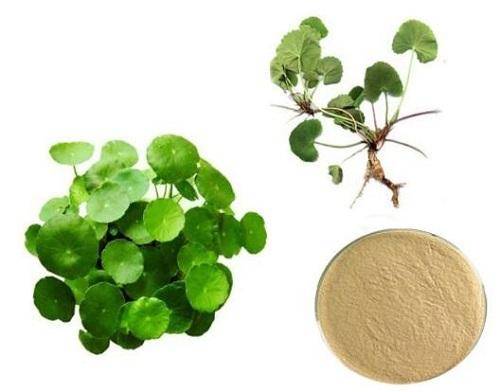
In the control group, placebo was given, and in the low, medium and high dose groups, 12 mg, 16 mg and 24 mg of total centella asiatica were given 3 times/day, and after 6 months of continuous treatment, the total effective rate of treatment, the pain relief rate, the change in the rate of compression of the prosthesis, and the incidence of adverse reactions were calculated, and the total effective rate of treatment in the low dose group, the medium dose group, and the high dose group was higher than that of the control group, and the experimental data showed that the total effective rate of the high dose group was higher than that of the control group. The total effective rate, pain relief rate and prosthesis compression rate of the high-dose group were higher than those of the middle and low-dose groups, which confirmed that the total glycosides of Centella asiatica could effectively treat CC, and found that Centella asiatica glycosides had certain analgesic effect.
3 Conclusion
In summary, the action mechanisms of Gotu Kola are related to anti-inflammatory, antifibrotic, antioxidant, apoptosis regulator, anti-tumor and damage repair mechanisms, and some of them are connected with each other. For example, the anti-tumor and damage repair effects of Centella asiatica can be achieved through anti-inflammatory, antioxidant and apoptosis-regulating mechanisms, the detailed mechanisms of which have not yet been fully elucidated, and with the progress of science and technology, the research on the mechanisms of Centella asiatica has been continuously deepened at the molecular level.
More and more mechanisms of action of Centella asiatica have been discovered and confirmed, but there are still some deficiencies in the current research, such as the fact that Centella asiatica contains many components, and there is a lack of uniform standards for the dosage forms, which makes it difficult to determine the active ingredients that play a specific role in the treatment of the disease; furthermore, the research is based on animal model experiments, which is different from the mechanism of the drug's action in the human body, and there is a lack of systematicity in the research, and other problems. In terms of clinical application, Centella asiatica is mostly used as a combination of auxiliary drugs in clinical application, and although good results have been achieved in clinical application, it is difficult to define the active ingredient in some of the studies; relatively few single drugs or classified preparations have been used in the studies, which also proves that Centella asiatica has a great value of research and prospects for development of clinical application. In conclusion, in order to provide better theoretical support for the clinical use of Centella asiatica and the development of new drugs, more systematic and in-depth studies on Centella asiatica extract are still needed, so that Centella asiatica can play a greater potential value in clinical applications.
Reference:
[1] National Pharmacopoeia Commission. Pharmacopoeia of the People's Republic of China: Part I (2020 Edition)[M]. Beijing: China Medical Science and Technology Press, 2020.
[2] Liang Jinyue, Li Yajuan, Liu Yayue, et al. Neuroprotective effect of volatile oil of Centella asiatica and its chemical composition[J]. West China Journal of Pharmacy, 2022 , 37(1): 53-57.
[3] HUANG Xiaoling, CHEN Wen, WANG Xiang, et al. Progress in the study of medicinal constituents of the Li medicine Centella asiatica[J]. Neijiang Science and Technology, 2021 , 42(3): 112-113.
[4] FERAH O I, OKKAY U, AYDIN I C, et al. Centella asiatica extract protects against cisplatininduced hepatotoxicity via targeting oxidative stress, inflammation, and apoptosis[J]. inflammation, and apoptosis[J]. Environmental Science and Pollution Research, 2022, 29:33774-33784.
[5] XU Chen, XU Hui-fu, SU Wen. Effects of asiaticoside on inflammation and Toll-like receptor 4/nuclear factor-κB signaling in lung tissue of asthmatic rats[J]. Chinese Journal of Clinical Pharmacology, 2022 , 38(6): 546-550.
[6] Huang Yalan. Correlation between PPARγ and inflammatory factor expression after intracerebroventricular injection of Aβ_(1-42) in rats, and the study of intervention with Centella asiatica[D]. Luzhou: Southwest Medical University, 2017.
[7] Zhang B, Yi Y, Wang J, et al. Centella asiatica glucoside attenuates the inflammatory response and tumor size of cerebral aneurysm wall in rats by down-regulating TLR9/MyD88/ NF-κB p65 [J]. Chinese Journal of Atherosclerosis, 2021 , 29(10): 851-856.
[8] ARRIBAS-LÓPEZ E, ZAND N, Ojo O, et al. A systematic review of the effect of Centella asiatica on wound healing [J]. International Journal of Environmental Research and Public Health, 2022, 19(6): 3266.
[9] Wang C. Study on the effect of Centella asiatica on renal fibrosis in rats with unilateral ureteral obstruction[J]. Chinese Medicine Clinical Research, 2017 , 9(20): 1-4.
[10] Feng Rui. Study on the expression of smad3 and smad7 in renal interstitial fibrosis by Centella asiatica based on TGF-β signaling pathway[D]. Zhengzhou: Henan University of Traditional Chinese Medicine, 2017.
[11] Li J. Study on the mechanism of the effects of Centella asiatica glycosides on cellular immunity and fibrosis in systemic sclerosis[D]. Kaifeng: Henan University, 2020.
[12] Hu Yue. Mechanism of the effects of cumulus humilis glycosides on angiotensin II-induced myocardial fibrosis in mice[D]. Jinzhou: Jinzhou Medical University, 2021.
[13] PAN Xiao-Cui, WANG Juan-Ke, LI Xiao-Bo, et al. Preparation of total glycosides from Centella asiatica and their antioxidant properties[J]. Shandong Chemical Industry, 2021 , 50(24): 14-17.
[14] VISARUT B, DOLLY R, ASHWINI M, et al. Insights into antioxidant activities and anti-skin-aging potential of callus extract from Centella asiatica ( L.)[J]. Scientific Reports, 2021, 11(1): 1038.
[15] ZWEIG J A, BRANDES M S, BRUMBACH B H, et al. Prolonged treatment with Centella asiatica improves memory,reduces amyloid-β pathology, and activates NRF2-regulated antioxidant response pathway in 5xFAD mice[J]. Journal of Alzheimer's Disease, 2021, 81(4): 1453-1468.
[16] Feng Shanshan, Yan Yu, Wang Lei. Protective effects of cumulus humilis glycosides on ischemia-reperfusion brain tissue injury in rats[J]. Journal of Medicine of the People's Liberation Army, 2021, 33(2): 1-4.
[17] ZHU Qin, CHEN Hongyu, ZENG Jiali. Effects of compound Centella asiatica on the renal protection of diabetic nephropathy rats and on the expression of heme oxygenase-1 and NADPH oxidase-4 proteins[J].
4 protein expression[J]. Chinese Journal of Nephrology, 2021, 22(2): 111-115.
[18] Mogan, You Jie, Yang Yan. Repair of radiation-induced small intestinal epithelial cell injury by hydroxycumisin[J]. Modern Digestive and Interventional Diagnosis and Treatment, 2021 , 26(11): 1390-1394, 1399.
[19] WANG Yao, YUAN Rui, LIU Guoliang. Effects of cumquat chloride on HSFB miR-564 and its mediated TGF-β_ 1/Smad signaling pathway[J]. Journal of Chinese Medicine, 2021 , 49(8): 32-36.
[20] JIANG Bin, ZHOU Qian, LU Liu Mei, et al. Effects of hydroxycitrin on apoptosis of human cervical cancer cells C-33A/CaSki[J]. Chinese Medicine Clinical Research, 2019 , 11(21): 78-80.
[21] YAN B F, CHEN X, LIU J, et al. Asiatic acid induces mitochondrial apoptosis via inhibition of JAK2/STAT3 signalling pathway in human osteosarcoma[J] . . Folia Biologica, 2021, 67(3): 108-117.
[22] NAIDOO D B, CHUTURGOON AA, PHULUKDAREE A, et al. Centella asiatica modulates cancer cachexia associated inflammatory cytokines and cell death in leukaemic THP-1 cells and peripheral blood mononuclear cells (PBMC's)[J]. BMC Complementary and Alternative Medicine, 2017, 17(1): 377.
[23] Wu, Yanwen. Research on the mechanism of action of Centella asiatica glycosides in the treatment of burn wounds[D]. Nanjing: Nanjing University of Traditional Chinese Medicine, 2019.
[24] Liu Bingying, Wang Wenbo, Huang Jia, et al. Glucosamine cumarate gel promotes wound healing and epidermal regeneration by regulating macrophage migration and polarization [J]. Journal of Tissue Engineering and Reconstructive Surgery, 2020 , 16(2): 112-118.
[25] Hu Rong, Jiang Runsong. Effect of cumulus humilis glycosides on the expression of heat shock protein 47 in wound healing and scar formation in rats with scalded wounds[J]. Zhejiang Medicine, 2020, 42(1): 36-38.
[26] TIAN Xu-Lu, LAN Cheng, CEN Yun-Guang, et al. Study on the protective effect of total glycosides of Centella asiatica on gastrointestinal motility and enteric nervous system in rats with indigestion[J]. Chinese Pharmacy, 2020 , 31(12): 1429-1435.
[27] FU Lianqiao, GUO Yanxiong, LI Jian, et al. Centella asiatica glucoside regulates miR-342-5p/AQP3 axis to protect IL-1β-induced chondrocyte damage[J]. Laboratory Animal Science, 2020 , 37(3): 10-18.
[28] MAI Langjun, FU Xuexing, HE Gang, et al. Protective effects of asiaticoside on bronchopulmonary dysplasia in neonatal rats induced by hyperoxia and its mechanism[J]. Chinese Journal of Contemporary Pediatrics, 2020 , 22(1): 71-76.
[29] YANG Fei, HUANG Hui, WANG Fang. Protective effect of cumquat chloride on myocardial ischemia/reperfusion injury and MAPK pathway in rats[J]. Chinese Journal of Hospital Pharmacy, 2021 , 41(15): 1514-1518.
[30] ZHANG Min, FANG Liming. Clinical observation on the treatment of chronic kidney disease by combining western medicine with Centella asiatica granules[J]. Journal of Practical Chinese Medicine, 2020, 34(12): 41-43.
[31] LI Xiaoyan, YU Dongrong, XIE Ting, et al. The effects of compound formula of Centella asiatica on renal function and nutritional status of patients with chronic kidney disease stage 4-5[J]. Chinese Journal of Integrative Nephrology, 2020 , 21(11): 962-965.
[32] Yu Maoqiang, Zhan Yucong, Lan Lili. Introduction of Liu Xiaoju's experience in treating chronic renal failure[J]. New Chinese Medicine, 2018 , 50(3): 209-211.
[33] ZHU Mengjie, BAO Ziyang, YU Liqiang, et al. Clinical study on the treatment of chronic glomerulonephritis chronic kidney disease in phase 3 by adding and subtracting compound Jiexuecao Tang[J]. New Chinese Medicine, 2019 , 51(11): 128-131.
[34] Sun W. Sun W. Effective prescription treatment experiment--Sugar kidney and renal failure formula[J]. Jiangsu Traditional Chinese Medicine, 2021 , 53(7): 7-8.
[35] Sun Yun. Observation on the clinical efficacy of compound Jiexuecao Combination in the treatment of early diabetic nephropathy[J]. Chinese Journal of Practical Internal Medicine, 2017 , 37(5): 467-468.
[36] CHAI Ke, CHEN Hongyu, ZENG Jiaoli. Clinical efficacy analysis of compound Jiexuecao 2 group formula in the treatment of stage III ~ IV diabetic nephropathy[J]. China Modern Physician, 2021 , 59(13): 139-143.
[37] Hu Yan. Analysis on the efficacy of kidney-strengthening, spleen-strengthening and dampness-resolving formula combined with candesartan ester in the treatment of diabetic nephropathy[J]. Clinical and Education of Family Medicine, 2020, 18(10): 941-943.
[38] WANG Jin, CHEN Xiabo, SONG Endi, et al. Benefiting qi, nourishing yin and eliminating symptoms of diabetes mellitus combined with valsartan in the treatment of early diabetic nephropathy in 50 cases[J]. Zhejiang Journal of Traditional Chinese Medicine, 2020, 55(3): 202-203.
[39] ZHAO Liangchen, WU Jiaming, MENG Jincheng, et al. “Compound Centella asiatica enema” for the treatment of malignant intestinal obstruction[J]. Jiangsu Traditional Chinese Medicine, 2020 , 52(12): 76-77.
[40] NG Jia-Ming, WU Le-Ha, ZHANG Vigorous, et al. Observation on clinical efficacy of compound Centella asiatica enema in the treatment of colorectal cancer combined with intestinal obstruction[J]. Journal of Traditional Chinese Medicine Oncology, 2022 , 4(1): 24-28.
[41] Zhong Hairong, Ding Cuishuang. Thirty-nine cases of skin injury after cumquat glycoside treatment of keloid[J]. Henan Traditional Chinese Medicine, 2017 , 37(4): 705-707.
[42] ZHOU Ling, YANG Yun, WU Yu, et al. Clinical analysis of fractional CO2 laser combined with cumenexin cream ointment in the treatment of keloid[J]. China Aesthetic Medicine, 2021 , 30(6): 90-94.
[43] Chen Yantu, Xu Xianjun, Liu Weiyuan. Clinical observation of skin rolling needle introduction of cumenexin cream ointment in the treatment of early proliferative scarring[J]. China Aesthetic Medicine, 2017 , 26(7): 29-31.
[44] HU Nan, XIAO Zhiping, WEN Yunpeng, et al. Clinical efficacy observation of cumquat glycoside combined with trichostatin in the treatment of limited scleroderma[J]. Dermatology and Venereology, 2019 , 41(4): 469-471.
[45] LI Zhichao, GUO Xia, WANG Shi, et al. Efficacy and effect on S100A8 and S100A9 in the treatment of limited scleroderma by combining oral administration of Centella asiatica glucoside tablets and external cleansing with dillon extract [J]. Modern Chinese and Western Medicine Combined Miscellany , 2018 , 27(30): 3340-3343.
[46] He Bangyou. Experience and experience of Chinese medicine in the treatment of idiopathic membranous nephropathy [J]. Chinese Medicine Clinical Journal, 2019 , 31(2): 273-276.
[47] Liu Xing, Chen Xing, Zhou Flood. Clinical study on the therapeutic effect of total glycosides of Centella asiatica on periosteal contracture after breast augmentation [J]. Chongqing Medicine, 2020 , 49(13): 2087-2089.


 English
English French
French Spanish
Spanish Russian
Russian Korean
Korean Japanese
Japanese